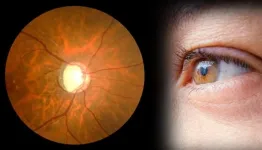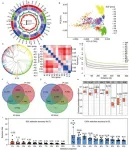(Press-News.org) UNIVERSITY PARK, Pa. — When it comes to deciding where they’re going to get their next meal, different species of bees may be attracted to different flower traits, according to a study led by researchers at Penn State and published in PNAS Nexus.
The study focused on two species of solitary bees: the horned-face bee, which helps pollinate crops like apples and blueberries, and the alfalfa leafcutting bee, which pollinates alfalfa.
The researchers found that the horned-face bees tended to prefer plants with a large number of flowers — for them, quantity was most important. Meanwhile, the alfalfa leafcutting bees tended to visit flowers with a high pollen protein-to-lipid, or more protein than fat, content ratio. In this case, they prioritized nutritional quality.
Jaya Sravanthi Mokkapati, first author on the study and a postdoctoral scholar in the Penn State College of Agricultural Sciences and Center for Pollinator Research, said that understanding how different bee species forage can help guide conservation efforts.
“Information on the foraging strategies of different bee species give insights for understanding how plant–pollinator interactions evolved,” Mokkapati said. “Our study also highlights the need for more research on seasonal foraging habits among various bee species, which can deepen our understanding of their vital role in pollination and plant reproduction.”
Pollinators and flowering plants have evolved side by side over thousands of years to develop a mutually beneficial relationship, the researchers said. As bees visit flowers to collect nectar and pollen for food, they help plants reproduce by spreading their pollen. Since many crops require pollination to produce their fruits, vegetables or nuts, the process underpins food security for humans.
Unfortunately, many pollinator populations are in decline, the researchers added, and a major contributor to these declines is the loss of flowering plants.
Understanding which floral traits are especially attractive to bees can help in restoring pollinator habitats, according to co-author Christina Grozinger, Publius Vergilius Maro Professor of Entomology and director of the Penn State Center for Pollinator Research.
“Bees can be attracted to plants based on a number of traits, such as the color, scent, size, number and nutritional content of its flowers,” she said. “However, because these traits are co-evolved in flowers, it can also be very challenging to pinpoint which traits are the ones attracting which bees.”
For the study, the researchers worked with their collaborators in the Swedish University of Agricultural Sciences, who crossed the self-fertilizing Capsella rubella plant and the pollinator-dependent outcrosser C. grandiflora to produce 20 different genetic lines of plants that varied across floral traits. These traits include floral resource quantity — assessed through the number and size of flowers — and floral nutritional quality, which was evaluated based on pollen protein concentration, lipid concentration and the protein-to-lipid ratios.
This resulted in different floral traits being uncoupled from each other, which allowed the researchers to test which trait, specifically, was most attractive to different bee species.
The differences in foraging behavior between the two species of bees may be due to resource availability, the researchers said. For example, the horned-face bee is a spring species that faces limited food sources that are only available for a short time. Because of this, they may forage for whatever is available and prioritize the quantity of flowers.
“In contrast, the alfalfa leafcutting bee is a summer species that typically has access to more abundant resources,” Mokkapati said. “We hypothesized that these bees can afford to be more selective, choosing flowers based on nutritional quality instead of quantity.”
The findings could be helpful for restoring pollinator habitats, the researchers said. For example, landscape managers could plant a variety of flowers that cater to the bees’ specific needs, which is essential for supporting their populations. They could also create habitats that ensure food sources are available that are attractive and nutrition for bees throughout the growing season, promoting healthy ecosystems.
Additionally, Mokkapati said educating the public and stakeholders about the specific needs of these bee species can encourage support for initiatives like native plant gardens and other efforts that create pollinator-friendly environments.
“By raising awareness of how these gardens can provide essential resources for bees, we can inspire community involvement and commitment to preserving local biodiversity,” she said. “This collective effort not only benefits the bees but also enhances the beauty and ecological health of our surroundings.”
The researchers said in the future, additional studies could explore why these species differ in their foraging strategies, especially in terms of their sensory and cognitive processes and why these different strategies evolved.
Michael Hill, former graduate student at Penn State; Natalie Boyle, assistant research professor of entomology at Penn State; Pierre Ouvrard, Swedish University of Agricultural Sciences; and Adrien Sicard, Swedish University of Agricultural Sciences, also co-authored this study.
This research was support by a grant from the Human Frontier Science Program to Grozinger, Sicard and Benjamin Risse, a collaborator at the University of Münster in Germany. Additional support was provided by the Penn State Huck Institutes of the Life Sciences and the United States Department of Agriculture’s National Institute of Food and Agriculture.
For more information on how to develop habitat to support diverse pollinator species, please visit the Center for Pollinator Research website and the Penn State Master Gardener Pollinator Habitat Certification Program.
END
Quantity over quality? Different bees are attracted to different floral traits
The research findings may help guide efforts to restore pollinator habitats
2025-01-02
ELSE PRESS RELEASES FROM THIS DATE:
Cancer-preventing topical immunotherapy trains the immune system to fight precancers
2025-01-02
A new study by investigators from Mass General Brigham uncovers how a novel immunotherapy prevents squamous cell carcinoma, with benefits lasting five years after treatment. This therapy is the first to activate specific components of the adaptive immune system, particularly CD4+ T helper cells, which are not known to be involved in traditional cancer treatments. This work highlights the potential for similar immunotherapies to prevent other cancers throughout the body. Results are published in the Journal of Clinical Investigation.
“One of the unique challenges with squamous cell carcinoma is that individuals who develop it are at an increased risk of developing multiple new ...
Blood test can predict how long vaccine immunity will last, Stanford Medicine-led study shows
2025-01-02
When children receive their second measles-mumps-rubella vaccine, around the time they start kindergarten, they gain protection against all three viruses for all or most of their lives. Yet the effectiveness of an influenza vaccine given in October starts to wane by the following spring.
Scientists have long been stymied by why some vaccines can coax the body to produce antibodies for decades, while others last mere months. Now, a study led by researchers at Stanford Medicine has shown that variation in vaccine durability can, in part, be pinned on a surprising type ...
The nose knows: Nasal swab detects asthma type in kids
2025-01-02
Researchers at the University of Pittsburgh have developed a nasal swab test for kids that diagnoses specific asthma subtype, or endotype. This non-invasive approach could help clinicians prescribe medications more precisely and pave the way for research toward better treatments for lesser-studied asthma types, which have been difficult to diagnose accurately until now.
Published today in JAMA, the findings are based on data from three independent U.S.-based studies that focused on Puerto Rican and African American youths, who have higher rates of asthma and are more likely to die from the disease than their non-Hispanic white counterparts.
“Asthma ...
Knowledge and worry following review of standard vs patient-centered pathology reports
2025-01-02
About The Study: Most study participants could not extract basic information—including whether they have cancer—from standard prostate cancer pathology reports but were able to understand this diagnostic information from the patient-centered pathology reports (PCPRs). Also, they discriminated between risk levels (i.e., lower levels of perceived worry in the low-risk condition) with PCPRs compared with standard reports. Hospital systems should consider including PCPRs with standard pathology reports to improve patient understanding.
Corresponding ...
Cardiovascular disease and breast cancer stage at diagnosis
2025-01-02
About The Study: This case-control study found that individuals with more advanced breast cancer at diagnosis were more likely to have prevalent cardiovascular disease. This finding may be specific to hormone receptor–positive and ERBB2-negative (formerly HER2) disease. Future studies are needed to confirm these findings and investigate interventions to improve patient outcomes, including personalized cancer screening.
Corresponding Author: To contact the corresponding author, Kevin T. Nead, MD, MPhil, email ktnead@mdanderson.org.
To access the embargoed study: Visit our For The Media website at this link https://media.jamanetwork.com/
(doi:10.1001/jamanetworkopen.2024.52890)
Editor’s ...
Herpes virus might drive Alzheimer's pathology, study suggests
2025-01-02
PITTSBURGH, Jan. 2, 2025 – University of Pittsburgh researchers uncovered a surprising link between Alzheimer’s disease and herpes simplex virus-1 (HSV-1), suggesting that viral infections may play a role in the disease. The study results are published today in Cell Reports.
The study also revealed how tau protein, often viewed as harmful in Alzheimer’s, might initially protect the brain from the virus but contribute to brain damage later. These findings could lead to new treatments targeting infections and the brain’s immune response.
“Our study challenges ...
Patients with heart disease may be at increased risk for advanced breast cancer
2025-01-02
HOUSTON ― Cardiovascular disease (CVD) and cancer are the two leading causes of death in the U.S. According to researchers from The University of Texas MD Anderson Cancer Center, patients diagnosed with late-stage or metastatic breast cancer have a statistically significant increased risk of pre-diagnosis CVD compared to those with early-stage cancer at diagnosis.
The study, published today in JAMA Network Open, found those with advanced breast cancer at diagnosis were 10% more likely to have had pre-existing ...
Chinese Medical Journal study reveals potential use of artificial intelligence (AI) in finding new glaucoma drugs
2025-01-02
Glaucoma is a progressive eye disorder characterized by fluid buildup inside the eye, causing ocular hypertension. By 2040, it is estimated that 111.8 million people worldwide will be affected by glaucoma, potentially leading to blindness if left untreated. Currently, there are treatments available to manage ocular hypertension, but a cure for glaucoma remains elusive.
Retinal ganglion cells (RGCs) are crucial for transmitting visual signals from the eyes to the brain, and their degeneration leads to optic nerve damage, which is a hallmark of glaucoma. In recent years, scientists ...
Genomic analysis of modern maize inbred lines reveals diversity and selective breeding effects
2025-01-02
Maize is a globally cultivated staple crop and one of the most successful examples of heterosis utilization in food production. The development of elite inbred lines is critical for breeding hybrid varieties and achieving sustained yield improvements. However, efficient breeding of inbred lines faces significant challenges, including the broad origins of germplasm resources, complex and diverse genetic structures, and low accuracy in phenotypic prediction. Advances in modern genomics and artificial intelligence technologies ...
Research alert: Enzyme promoting tumor growth and spread in pancreatic cancer identified
2025-01-02
Pancreatic cancer kills 50,000 people each year, according to the National Cancer Institute, and there are few effective treatment options for the disease. In a new study, researchers at University of California San Diego School of Medicine have discovered that an enzyme called MICAL2 promotes tumor growth and spread in pancreatic ductal adenocarcinomas (PDAC), the most common form of pancreatic cancer. The study will be published on January 2, 2025 in Cancer Research, a journal of the American Association for Cancer Research.
Normally, MICAL2 plays an important role in cell migration and morphology. But when the researchers measured ...
LAST 30 PRESS RELEASES:
Making lighter work of calculating fluid and heat flow
Normalizing blood sugar can halve heart attack risk
Lowering blood sugar cuts heart attack risk in people with prediabetes
Study links genetic variants to risk of blinding eye disease in premature infants
Non-opioid ‘pain sponge’ therapy halts cartilage degeneration and relieves chronic pain
AI can pick up cultural values by mimicking how kids learn
China’s ecological redlines offer fast track to 30 x 30 global conservation goal
Invisible indoor threats: emerging household contaminants and their growing risks to human health
Adding antibody treatment to chemo boosts outcomes for children with rare cancer
Germline pathogenic variants among women without a history of breast cancer
Tanning beds triple melanoma risk, potentially causing broad DNA damage
Unique bond identified as key to viral infection speed
Indoor tanning makes youthful skin much older on a genetic level
Mouse model sheds new light on the causes and potential solutions to human GI problems linked to muscular dystrophy
The Journal of Nuclear Medicine ahead-of-print tip sheet: December 12, 2025
Smarter tools for peering into the microscopic world
Applications open for funding to conduct research in the Kinsey Institute archives
Global measure underestimates the severity of food insecurity
Child survivors of critical illness are missing out on timely follow up care
Risk-based vs annual breast cancer screening / the WISDOM randomized clinical trial
University of Toronto launches Electric Vehicle Innovation Ontario to accelerate advanced EV technologies and build Canada’s innovation advantage
Early relapse predicts poor outcomes in aggressive blood cancer
American College of Lifestyle Medicine applauds two CMS models aligned with lifestyle medicine practice and reimbursement
Clinical trial finds cannabis use not a barrier to quitting nicotine vaping
Supplemental nutrition assistance program policies and food insecurity
Switching immune cells to “night mode” could limit damage after a heart attack, study suggests
URI-based Global RIghts Project report spotlights continued troubling trends in worldwide inhumane treatment
Neutrophils are less aggressive at night, explaining why nighttime heart attacks cause less damage than daytime events
Menopausal hormone therapy may not pose breast cancer risk for women with BRCA mutations
Mobile health tool may improve quality of life for adolescent and young adult breast cancer survivors
[Press-News.org] Quantity over quality? Different bees are attracted to different floral traitsThe research findings may help guide efforts to restore pollinator habitats




